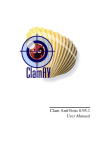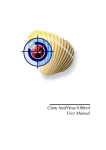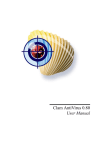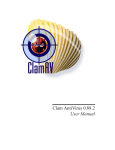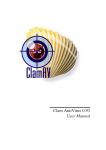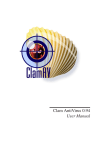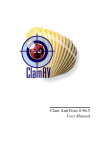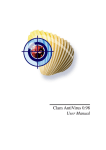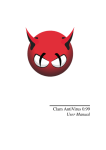Download Clam AntiVirus: User Manual
Transcript
Clam AntiVirus: User Manual version 0.60 Tomasz Kojm 1 Contents Contents 1 Introduction 1.1 Features . . . . . . . . . . . . . . . . . . . . . . . . . . . . . . . 1.2 Mailing lists . . . . . . . . . . . . . . . . . . . . . . . . . . . . . 1.3 Virus submitting . . . . . . . . . . . . . . . . . . . . . . . . . . . 3 3 3 4 2 Installation 2.1 Requirements . . . . . . . . . . . . 2.2 Supported platforms . . . . . . . . . 2.3 Actual versions . . . . . . . . . . . 2.4 Binary packages . . . . . . . . . . . 2.5 Installation . . . . . . . . . . . . . 2.6 Configuration . . . . . . . . . . . . 2.7 Testing . . . . . . . . . . . . . . . . 2.8 FreshClam: Setting up auto-updating 2.9 FreshClam: Mirrors and mirrors.txt . . . . . . . . . . . . . . . . . . . . . . . . . . . . . . . . . . . . . . . . . . . . . . . . . . . . . . . . . . . . . . . . . . . . . . . . . . . . . . . . . . . . . . . . . . . . . . . . . . . . . . . . . . . . . . . . . . . . . . . . . . . . . . . . . . . . . . . . . . . . . . . . 4 4 4 5 5 6 7 8 8 9 Usage 3.1 Clam daemon . . . . . . . . . 3.2 Clamuko . . . . . . . . . . . . 3.3 Archives and compressed files 3.4 Output format . . . . . . . . . 3.5 Signature Tool . . . . . . . . . . . . . . . . . . . . . . . . . . . . . . . . . . . . . . . . . . . . . . . . . . . . . . . . . . . . . . . . . . . . . . . . . . . . . . . . . . . . . . . . . 9 9 10 11 13 14 . . . . . . . . . . . . 15 15 16 16 17 17 17 17 18 18 18 18 18 3 4 Compatible software 4.1 clamav-milter . . . . . . . . . 4.2 mod clamav . . . . . . . . . . 4.3 TrashScan . . . . . . . . . . . 4.4 AMaViS - ”Next Generation” . 4.5 amavisd-new . . . . . . . . . 4.6 Qmail-Scanner . . . . . . . . 4.7 Sagator . . . . . . . . . . . . 4.8 ClamdMail . . . . . . . . . . 4.9 BlackHole . . . . . . . . . . . 4.10 MailScanner . . . . . . . . . . 4.11 MIMEDefang . . . . . . . . . 4.12 Exiscan . . . . . . . . . . . . . . . . . . . . . . . . . . . . . . . . . . . . . . . . . . . . . . . . . . . . . . . . . . . . . . . . . . . . . . . . . . . . . . . . . . . . . . . . . . . . . . . . . . . . . . . . . . . . . . . . . . . . . . . . . . . . . . . . . . . . . . . . . . . . . . . . . . . . . . . . . . . . . . . . . . . . . . . . . . . . . . . . . . . . . . . . . . . . . . . . . . . . . . . . . . . . . . . . . . . . . . . . . . . . . . . . . . . . . . . . . . . . . . . . . . . Contents 2 5 LibClamAV 5.1 API . . . . . . . . . . . . . . . . . . . . . . . . . . . . . . . . . 19 19 6 Problem solving 6.1 Return codes . . . . . . . . . . . . . . . . . . . . . . . . . . . . 22 22 7 Technicals 7.1 Security . . . . . . . . . . . . . . . . . . . . . . . . . . . . . . . 7.2 Scan engine . . . . . . . . . . . . . . . . . . . . . . . . . . . . . 23 23 23 8 Credits 24 9 Authors 28 1 Introduction 1 3 Introduction Clam AntiVirus is an anti-virus toolkit for UNIX. The main purpose of this software is the integration with mail servers (attachment scanning). The package provides a flexible and scalable multi-threaded daemon, a command line scanner, and a tool for automatic updating via Internet. The programs are based on a shared library distributed with the Clam AntiVirus package, which you can use with your own software. The virus database is based on the virus database from OpenAntiVirus.org, but contains additional signatures (including signatures for popular polymorphic viruses, too) and is kept up to date. 1.1 Features GNU GPL v2 license POSIX compliant, portable Secure Very fast Multi-threaded User friendly On-access scanning (Linux only) Detects over 7000 viruses, worms and trojans Supports compressed files and archives Built-in support for RAR (2.0), Zip, Gzip, Bzip2 1.2 Mailing lists There are three mailing lists available: [email protected] - info about new versions (including debian package releases), moderated1 . [email protected] - user questions [email protected] - developement 1 That means, the subscribers are not allowed to write into the mailing list 4 2 Installation [email protected] - database update information You can subscribe by sending an empty email to [email protected], or via www at http://clamav.elektrapro.com/ml After subscribing you must reply to a special message sent at your address. Mailing lists are archived at: http://archive.elektrapro.com/clamav.elektrapro.com/users/ http://archive.elektrapro.com/clamav.elektrapro.com/devel/ 1.3 Virus submitting If you have a virus that is not detected by ClamAV with the latest database, please send it (as a normal attachment) to: [email protected] If your system doesn’t allow you to send infected files, please archive the virus sample into a zip archive with password: virus 2 Installation 2.1 Requirements You will need the zlib and zlib-devel packages and the gcc compiler (both 2.9x and 3.x are supported). You can install the bzip2 library (and its development files) to get bzip2 support, but this is not required. 2.2 Supported platforms Clam AntiVirus is prepared for the installation on the following operating systems / architectures (tested platforms in brackets): GNU/Linux 2.2/2.4 (All flavours, Intel/SPARC/Alpha/zSeries/S/390) Solaris 2.6/7/8/9 (Intel/SPARC) FreeBSD 4.5/6/7 5.0 (Intel/Alpha) OpenBSD 3.0/1/2 (Intel) AIX 4.1/4.2/4.3/5.1 (RISC 6000) 5 2 Installation HPUX 11.0 SCO UNIX Mac OS X BeOS Cobalt MIPS boxes (RAQ1, RAQ2, QUBE2) Windows/Cygwin Some features may not be available with your operating system. If you have run Clam AntiVirus on the system not listed above, please let us know. 2.3 Actual versions Clam AntiVirus can be obtained from: http://clamav.elektrapro.com The site is sponsored by ElektraPro.com 2.4 Binary packages There are high quality deb and rpm packages available for Linux. The Debian package is maintained by Magnus Ekdahl and you will find it on debian mirrors, http://www.debian.org. The RPM package is maintained by Arkadiusz Miskiewicz and is distributed with Polish(ed) Linux Distribution (ftp://ftp. pld.org.pl). There is also the RPM package for Mandrake available, it’s maintained by Oden Eriksson and can be found on Mandrake mirrors. The binary packages for AIX are available in AIX PDSLIB, UCLA http://aixpdslib. seas.ucla.edu/packages/clamav.html. The official FreeBSD port is maintained by Masahiro Teramoto. The unofficial port for OpenBSD (maintained by Flin Mueller) is available at: http://www.activeintra.net/openbsd/article.php?id=5. 2 Installation 6 2.5 Installation Please read the README file in the current version, because it probably contains some important release notes. If you are installing Clam AV for the first time, you have to add a new user and group to your system - clamav: 2 # groupadd clamav # useradd -g clamav -s /bin/false -c "Clam AntiVirus" clamav The above method works on Linux and Solaris, if you don’t have groupadd, useradd please consult your system manual - the section about creating new users and groups. If you are not a system administrator or won’t be using clamscan in superuser mode, you may omit this step with the option –disable-clamav passed to the configure script: $ ./configure --disable-clamav This disables test for the clamav user and group. clamscan still requires clamav for superuser mode. Please don’t set a password on this account, just assure it’s locked with ”!” in /etc/passwd or /etc/shadow. It must be a normal, unprivileged user. Don’t add it to any supplementary groups. After you have created the clamav user/group, extract the archive: $ zcat clamav-x.yz.tar.gz | tar xvf $ cd clamav-x.yz Assuming you want the configuration file installed in /etc, configure the package as follows: $ ./configure --sysconfdir=/etc Currently gcc is required for the compilation. Support for other compilers will be added in a near future. $ make $ su -c "make install" In the last step the software is installed in the /usr/local directory and the config file in /etc. WARNING: Never set SUID/SGID bit on Clam AntiVirus programs. 2 Cygwin note: If you don’t have /etc/passwd, you don’t need the clamav user/group. 2 Installation 7 2.6 Configuration If you are going to use the daemon, you need to configure it. $ clamd ERROR: Please edit the example config file /etc/clamav.conf. Now you know, where the configuration file is located ;). The format and options of this file are fully described in the clamav.conf(5) manual. clamd configuration is rather easy, the config file is well commented. Remember, you must remove the ”Example” directive. Another feature of clamd is on-access scanning based on the Dazuko module, available from http://dazuko.org. This is not required to run clamd, furthermore you shouldn’t run Dazuko on production systems. A special thread in clamd responsible for the communication with Dazuko is called ”Clamuko” (it’s due to the funny name of Dazuko - I don’t know what Clamuko means). Clamuko is supported on Linux 2.2 and 2.4 only. Dazuko instalation: $ tar zxpvf dazuko-a.b.c.tar.gz $ cd dazuko-a.b.c $ make dazuko or $ make dazuko-smp (for smp kernels) $ su # insmod dazuko.o # cp dazuko.o /lib/modules/‘uname -r‘/misc # depmod -a Depending on your Linux distribution you have to add ”dazuko” entry to /etc/modules or the following line: modprobe dazuko to some startup file to load dazuko at the boot time. You must also create the /dev/dazuko device: $ cat /proc/devices | grep dazuko 254 dazuko $ su -c "mknod -m 600 /dev/dazuko c 254 0" Now you must configure Clamuko in clamav.conf. Please check 3.2 section. 2 Installation 8 2.7 Testing OK. Let’s do some tests. Try to scan the source directory recursively: $ clamscan -r -l scan.txt clamav-x.yz It should find the viruses in the clamav-x.yz/test directory. You may check it in the created log - scan.txt. You will find more about clamscan options in the clamscan(1) manual. 3 To test clamd first start it and then use clamdscan (you can also connect directly to clamd and run the SCAN command): $ clamdscan -l scan.txt clamav-x.yz 2.8 FreshClam: Setting up auto-updating The freshclam utility is the default database updater for Clam AntiVirus. It works in two modes: interactive - from command line as a daemon - works alone, silently When started by the superuser it drops the privileges, by default it works as clamav. freshclam downloads the database from the Clam AntiVirus homepage and checks its consistency using MD5 sum. process for Clam AntiVirus. Run freshclam (as root) without any parameters to check is it working correctly. If everything is OK, create the log file in /var/log owned by clamav: # touch /var/log/clam-update.log # chmod 600 /var/log/clam-update.log # chown clamav /var/log/clam-update.log Now you can run freshclam as a daemon: # freshclam -d -c 2 -l /var/log/clam-update.log It will check for a new database 2 times a day. Please add the above line to your startup scripts. The other way is to use the cron daemon. You have to add a similar line to the crontab of root or clamav: 3 Please run man clamscan 3 Usage 9 0 8 * * * /usr/local/bin/freshclam --quiet -l /var/log/clam-update.log It will check for a new database daily at 8 am. You may need to setup the proxy support on your system. You should set the environment variable $http proxy, eg. export http_proxy="my.proxy.server:8080" There is also –http-proxy and –proxy-user option available. 2.9 FreshClam: Mirrors and mirrors.txt The main server is clamav.elektrapro.com and there are the following mirrors available: clamav.ozforces.com - database mirror updated manually clamav.essentkabel.com - full mirror of the main site updated automatically clamav.linux-sxs.org - database mirror (rsync from ozforces) In the database directory you will find mirror.txt file, which freshclam reads each time it tries to download the new database. It uses the first server from the file and switches to another one (and remembers that position for some time) when the previous is not available. You can modify that file if you will find some mirror faster, however this is not recommended. 3 Usage 3.1 Clam daemon clamd is a fully multi-threaded daemon, based on libclamav. It’s able to work in one of the two modes, using: Unix (local) sockets TCP sockets The daemon is configured by the clamav.conf file. You will find a description of all the options in the clamav.conf(5) manual. clamd recognizes the following commands: 3 Usage 10 PING Check server’s state. It should reply with ”PONG”. VERSION Print the version information. RELOAD Reload the databases. QUIT Perform a clean exit. SCAN file/directory Scan a file or directory (recursively) with archive support. A full path is required. RAWSCAN file/directory Scan a file or directory (recursively) with archive support disabled. A full path is required. CONTSCAN file/directory Scan a file or directory (recursively) with archive support enabled and continue scanning even when virus was found. A full path is required. STREAM Scan stream - on this command clamd will return ”PORT number” and you can connect to that port and send a data to scan. Internal threads (except clamuko) are ignoring all external signals. The main thread handles SIGTERM and SIGINT signals and performs a proper exit when one of them is caught. 3.2 Clamuko Clamuko is a special thread in clamd, that performs on-access scanning under Linux. It was implemented as a thread in clamd because of Dazuko implementation. Client (clamuko) - server (clamd) model is currently not supported by Dazuko. There are some benefits from current implementation - clamuko is sharing the database with clamd, and it’s updated with the RELOAD command. You must obey the following principles when using clamuko: Always stop the daemon cleanly, with QUIT command or SIGTERM signal. In other case, you can lose an access to the protected files until the system is restarted. Never protect the directory your mail-scanner software uses for attachments unpacking. Access to all infected files will be blocked, and the scanner (even clamd) won’t be able to detect a virus. Infected mail will be delivered. 3 Usage 11 You need to enable clamuko in clamav.conf. To protect directory /home, please use the option: ClamukoIncludePath /home To protect the whole system: ClamukoIncludePath / ClamukoExcludePath /proc ClamukoExcludePath /tempdir/of/mail/scanner You can use clamuko to protect file access on Samba/Netatalk. NFS is not supported (Dazuko doesn’t intercept NFS access calls). Another idea - you can build a database containing a signatures of the popular exploits, it will protect you against script-kiddies. 3.3 Archives and compressed files Clam AntiVirus depends on LibClamAV. It has built-in support for the following formats: Zip Gzip RAR (2.0 only) Archive files are detected by checking a magic strings.4 You need the zlib library for the Zip/Gzip support. Zip archives are accessed with the zziplib library by Guido Draheim and Tomi Ollila. RAR support is based on the UniquE RAR File Library by Christian Scheurer and Johannes Winkelmann. Both of them are included and slightly modified in the clamav sources. Unrarlib supports RAR 2.0 archives only and according to Christian the new format (introduced in WinRAR 3.0) won’t be supported. The daemon scans archives supported by libclamav only. Clamscan tries to scan an archive with built-in code, but when it fails it’s able to switch to the external unpacker: 4 Just like the file(1) command. 12 3 Usage $ clamscan --unrar rarfail.rar /home/zolw/Clam/test/rarfail.rar: RAR module failure. UNRAR 3.00 freeware Copyright (c) 1993-2002 Eugene Roshal Extracting from /home/zolw/Clam/test/rarfail.rar Extracting test1 All OK /tmp/44694f5b2665d2f4/test1: ClamAV-Test-Signature FOUND /home/zolw/Clam/test/rarfail.rar: Infected Archive FOUND OK clamscan supports many popular compressors - it uses external programs for each format. If the scanner runs with superuser privileges unpackers are executed with clamav privileges, which makes the process far more secure. It also makes sure, that clamav user has read access to all scanned compressed files. You should have enabled recursive scanning with the -r option (–recursive), if you want to scan the whole content of the archive (with subdirectories), also all archives in archives will be recursively scanned - just everything. If files in archives are virus free the archive itself is scanned - just for prevention (it may not be an archive). Please look at the options below, each option has an optional argument - the absolute path to unpacker. If it can’t be found in $PATH please supply it. Because Clam AntiVirus uses the standard GNU options format, the long options with optional arguments, you must remember about the between option and argument. So the proper way to supply the optional arguments is for example –unzip=/path/to/unzip. –unzip: You probably don’t need this option, because Zip is supported by libclamav. But if libclamav will fail to unzip some file, it may be useful. clamscan was tested with UnZip 5.41 of 16 April 2000, by Info-ZIP. –unrar: Tested with UNRAR 3.00 freeware. –unace: It uses options supported by UNACE v1.2 public version, not tested, but should work. –arj: Tested with arj 3.10b. –zoo: Tested with zoo 2.1. –lha: Tested with LHa for Unix V 1.14e. –jar: CA uses unzip for .jar files. Tested with UnZip 5.41 of 16 April 2000, by 3 Usage 13 Info-ZIP. –tar: This option supports non-compressed archives. Tested with GNU tar 1.13.17. –deb: This option supports debian binary packages. Tested with GNU ar 2.12.90.0.14. Implies –tgz , but doesn’t conflict with –tgz=FULLPATH. –tgz: This option supports .tar.gz and .tgz files. You need GNU tar, on non-Linux system you probably have it as gtar and if this is in $PATH just use –tgz=gtar or supply the full path to this command as an argument. 3.4 Output format clamd uses clamscan compatible (see below) output format. zolw@Wierszokleta:˜$ telnet localhost 3310 Trying 127.0.0.1... Connected to localhost. Escape character is ’ˆ]’. SCAN /home/zolw/infected /home/zolw/infected/sobre.com: W32/Magistr.B FOUND Connection closed by foreign host. In SCAN mode it closes the connection when first virus is found. In the case of archives, the output is exactly the same as with normal files: SCAN /home/zolw/Clam/test/test2.zip /home/zolw/Clam/test/test2.zip: ClamAV-Test-Signature FOUND CONTSCAN displays all infected files found. Error messages are printed in the following format: SCAN /no/such/file /no/such/file: Can’t stat() the file ERROR and they can be easily parsed. clamscan writes all messages (only help is written to stdout by default) to stderr. In some situations you may want to redirect it to stdout with –stdout. stdout in contrast to stderr is buffered, that’s why clamscan flushes this buffer after each message, to prevent the creation of trashes on the output. During scanning it writes something like this: 3 Usage 14 /TEST/test: OK /TEST/Makefile: OK /TEST/getopt.c: OK /TEST/virfile: Phantom #1 FOUND When a virus is found, its name is printed between filename: and FOUND. If a virus is found in an archive scanned with an external unpacker it’s noticed with Infected Archive. ”Infected Archives” are not counted as infected files - just files in them are. Please note the difference between an internal unarchiving - because it’s realized transparently by the libclamav, clamscan doesn’t even know the file is an archive. 3.5 Signature Tool sigtool automates signature creation. If you have an infected file, which isn’t detected by ClamAV, but it is by another anti-virus scanner working in the console, you can create the signature easily. Example of usage: Create a random file and put the test1 file content into it. We will use clamscan to generate the signature, it’s just an example. Scan it with clamscan –stdout testfile, the output is testfile: ClamAV-Test-Signature FOUND ----------- SCAN SUMMARY ----------Known viruses: 7734 Scanned directories: 0 Scanned files: 1 Data scanned: 0.95 Mb Infected files: 1 I/O buffer size: 131072 bytes Time: 0.245 sec (0 m 0 s) The unique string in this output is ”ClamAV-Test-Signature”. Run sigtool with the following parameters: $ sigtool -c "clamscan --stdout" -f testfile -s "ClamAV-Test" The program will concatenate arguments for -c (–command) and -f (–file), that’s why the scanner’s options must be given in the proper order. At the end it will generate a file testfile.sig, which should contain 100 bytes in our example. It contains the proper signature. 4 Compatible software 15 ... ... Detected at 12103, moving backward. Detected at 11983, moving backward. Detected at 11923, moving backward. Not detected, increasing pos 11893 -> 11923 Detected at 11923, moving backward. Not detected, increasing pos 11908 -> 11923 Detected at 11923, moving backward. Not detected, increasing pos 11915 -> 11923 Detected at 11923, moving backward. Detected at 11919, moving backward. Detected at 11917, moving backward. Detected at 11916, moving backward. Starting precise loop *** Found signature end at 11916 The scanner was executed 46 times. Signature length is 50, so length of hex string should be 100 Saving signature in testfile.sig file. 4 Compatible software The following software supports ClamAV. It’s specified which elements are supported, please note that if the program doesn’t support clamd you can use clamdscan instead of clamscan. 4.1 clamav-milter Location: included in clamav package Supports: clamd clamav-milter by Nigel Horne is a very fast email scanner designed for sendmail. It’s entirely written in C and uses ClamAV’s internal mail scanner (also written by Nigel). Installation: You need libmilter development files. Configure ClamAV with $ ./configure --enable-milter 4 Compatible software 16 and recompile. The program will be installed in /usr/local/sbin/clamav-milter. The following instructions were adopted from Nigel’s INSTALL file: add to /etc/mail/sendmail.mc: INPUT_MAIL_FILTER(‘clmilter’,‘S=local:/var/run/clmilter.sock, F=, T=S:4m;R:4m’)dnl define(‘confINPUT_MAIL_FILTERS’, ‘clmilter’) Check entries in clamav.conf of the form: LocalSocket /var/run/clamd.sock ScanMail SaveStreamToDisk Start clamav-milter: /usr/local/sbin/clamav-milter -blo /var/run/clmilter.sock and restart sendmail. 4.2 mod clamav Location: http://software.othello.ch/mod\_clamav Supports: libclamav, clamd mod clamav is an Apache virus scanning filter. It was written and is currently maintained by Andreas Mller. The project is very well documented and the installation is quite easy. 4.3 TrashScan Location: clamav-sources/support/trashscan Supports: clamscan This is a procmail based scanner from Trashware and it’s extremely easy to setup, however this is for single users only and not as efficient as MTA based scanners. 4 Compatible software 17 4.4 AMaViS - ”Next Generation” Location: http://sourceforge.net/projects/amavis Supports: clamscan AMaViS-ng is a rewritten, more modular version of amavis-perl/amavisd, developed by Hilko Bengen. Home site: Installation: Please download the newest version (at least 0.1.4). After installation (which is quite easy), please uncomment the following line in amavis.conf: virus-scanner = CLAM and eventually change the path to clamscan in the [CLAM] section: [CLAM] clamscan = /usr/local/bin/clamscan 4.5 amavisd-new Location: http://www.ijs.si/software/amavisd Supports: clamd, clamscan amavisd-new is a rewritten version of amavis maintained by Mark Martinec. Installation: clamscan is enabled automatically if clamscan binary is found at amavisd-new starup time. clamd is activated by uncommenting its entry in the @av scanners list, file /etc/amavisd.conf. 4.6 Qmail-Scanner Location: http://qmail-scanner.sf.net Supports: clamscan You must increase softlimit value or wait for a daemon support. 4.7 Sagator Location: http://www.salstar.sk/sagator Supports: clamscan, clamd, libclamav 4 Compatible software 18 This program is an email antivirus/antispam gateway. It is an interface to the postfix (or any other smtpd), which runs antivirus and/or spamchecker. Its modular architecture can use any combination of antivirus/spamchecker according to configuration. 4.8 ClamdMail Location: http://clamdmail.sf.net Supports: clamd A mail processing client for ClamAV. Small, fast and easy to install. 4.9 BlackHole Location: http://www.groovy.org/blackhole.shtml Supports: clamscan, clamd BlackHole is an advanced spam / virus filter for Qmail, Postfix, Sendmail, Exim and Courier written by Chris Kennedy. This tool is for advanced administrators (installation is hard). 4.10 MailScanner Location: http://www.mailscanner.info Supports: clamscan MailScanner scans all e-mail for viruses, spam and attacks against security vulnerabilities. It is not tied to any particular virus scanner, but can be used with any combination of 14 different virus scanners, allowing sites to choose the ”best of breed” virus scanner. 4.11 MIMEDefang Location: http://www.roaringpenguin.com/mimedefang Supports: clamscan, clamd This is an efficient mail scanner for Sendmail/milter. 4.12 Exiscan Location: http://duncanthrax.net/exiscan Supports: clamscan, clamd exiscan is a patch against exim version 4, providing support for content scanning 5 LibClamAV 19 in email messages received by exim. Four different scanning facilities are supported: antivirus, antispam, regular expressions, and file extensions. 5 LibClamAV libclamav may be used to add a virus protection into your software. The library is thread-safe, automatically recognizes and scans an archives. Scanning is very fast - in most cases it won’t be noticeable. 5.1 API Each program using libclamav must include clamav.h header file: #include <clamav.h> The first step is an engine initialization. There are three functions available: int cl_loaddb(const char *filename, struct cl_node **root, int *virnum); int cl_loaddbdir(const char *dirname, struct cl_node **root, int *virnum); char *cl_retdbdir(void); cl loaddb() loads one database per time, cl loaddbdir() loads all .db and .db2 files from the directory dirname. cl retdbdir() returns hardcoded database directory path. The database will be saved under root and the number of the loaded signatures will be added to virnum. Pointer to the tree structure (trie, see 7.2) must initially point to the NULL. If you don’t want to save the number of signatures loaded pass the NULL as the third argument. cl loaddb functions return 0 on success and other value on failure. struct cl_node *root = NULL; int ret; ret = cl_loaddbdir(cl_retdbdir(), &root, NULL); 5 LibClamAV 20 There’s elegant way to print libclamav’s error codes: char *cl_perror(int clerror); cl perror() returns a (statically allocated) string describing clerror code: if(ret) { printf("cl_loaddbdir() error: %s\n", cl_perror(ret)); exit(1); } When database is loaded, you must create the proper trie with: void cl_buildtrie(struct cl_node *root); In our example: cl_buildtrie(root); OK, now you can scan a buffer, descriptor or file with: int cl_scanbuff(const char *buffer, unsigned int length, char **virname, const struct cl_node *root); int cl_scandesc(int desc, char **virname, unsigned long int *scanned, const struct cl_node *root, const struct cl_limits *limits, int options); int cl_scanfile(const char *filename, char **virname, unsigned long int *scanned, const struct cl_node *root, const struct cl_limits *limits, int options); All the functions save a virus name address under virname pointer. virname points to the name in the trie structure, thus it can’t be released directly. cl scandesc() and cl scanfile() can increase scanned value in CL COUNT PRECISION units. They also support archive limits: struct cl_limits { int maxreclevel; int maxfiles; long int maxfilesize; }; 5 LibClamAV 21 The last argument configures scan engine. Currently it supports CL ARCHIVE (enables archive scanning), CL RAW (disables archive scanning) and CL MAIL (enables mbox and Maildir scanning). The functions return 0 (CL CLEAN) when no virus is found, CL VIRUS when virus is found and other value on failure. struct cl_limits limits; char *virname; /* maximal number of files in archive */; limits.maxfiles = 100 /* maximal archived file size == 10 Mb */ limits.maxfilesize = 10 * 1048576; /* maximal recursion level */ limits.maxreclevel = 8; if((ret = cl_scanfile("/home/zolw/test", &virname, NULL, root, &limits, CL_ARCHIVE)) == CL_VIRUS) { printf("Detected %s virus.\n", virname); } else { printf("No virus detected.\n"); if(ret != CL_CLEAN) printf("Error: %s\n", cl_perror(ret)); } When you don’t need to scan more files, the trie should be released with: void cl_freetrie(struct cl_node *root); You will find some examples in clamav sources. Each program using libclamav must be linked against it: gcc -Wall ex1.c -o ex1 -lclamav Enjoy ! 22 6 Problem solving 6 Problem solving 6.1 Return codes Return codes are very useful, especially in system scripts. You may check the return code from clamscan, by running the following command directly after the scanner exits: $ echo $? Here is a list of return codes from clamscan: 0: No virus was found. 1: Virus(es) detected. 40: Unknown option was passed to clamscan. Please check clamscan –help or manual page for available options. 50: Problem with initialization of virus database. Probably it doesn’t exist in the default place or wrong file was passed to –database. 51: Wrong number of threads was passed to –threads. It must be a natural number 0. 52: Not supported file type. Scanner supports regular files, directories and symlinks. 53: Can’t open directory. 54: Can’t open file.5 55: Error reading file. Probably the medium you are reading is broken. 5 56: Can’t stat input file or directory. File / directory you want to scan doesn’t exist. 57: Can’t get absolute pathname of current working directory. Your current pathname is longer then 200 characters. When clamscan is started without a input file / directory it scans the current directory. For some reasons it needs absolute pathnames, the buffer is hardcoded to 200 characters and that should be sufficient. 58: I/O error. Please check the filesystem. 59: Can’t get information about current user (running clamscan). 60: Can’t get information about user clamav. User clamav (default unprivileged user) doesn’t exist in /etc/passwd. 5 Only in one-file mode (in recursive mode those errors are ignored) 7 Technicals 23 61: Can’t fork. Can’t create new process, please check your limits. 63: Can’t create temporary file or directory. Please check permissions. 64: Can’t write to temporary directory. Please specify another one. 70: Can’t allocate and clear memory. This is a critical error, please check your system. 71: Can’t allocate memory. Look above. 7 Technicals 7.1 Security Clam AntiVirus cares about security. Dangerous operations in clamscan (such as extracting, temporary file creation, unlink() operations) are executed with clamav privileges. But there are no programs without bugs. This is a young project and everything is possible. In some places it uses the snprintf() function, some older systems (C libraries) however the buffer length in this function isn’t checked. This example shows, that you should check your system first. Never set SUID/SGID bits on Clam AntiVirus executables. If the SUID bit is set and clamscan is owned by root, every file on the system may be modified with the –log option. Normal users may use clamscan to scan their files, other files shouldn’t interest them. Clam AntiVirus Daemon was written with security in mind - it doesn’t allow external unpackers (uses only libclamav unarchivers) and contains some additional protections. 7.2 Scan engine New versions of Clam AntiVirus are using a mutation of Aho-Corasick pattern matching algorithm. This algorithm uses a finite state pattern matching automaton [1]. The algorithm itself is a generalization of the Knuth-Morris-Pratt algorithm. Please look at matcher.h for data type definitions. The automaton is represented by the trie. Trie is a rooted tree with some specific properties [2]. Each node of the trie represents some state of the automaton. In the implementation, the node is defined as following: struct node { int islast; struct patt *list; int maxpatlen; 8 Credits 24 struct node *next[NUM_CHILDS], *trans[NUM_CHILDS], *fail; }; [To be continued...] 8 Credits In alphabetical order: AIX PDSLIB, University of California at Los Angeles http://aixpdslib.seas.ucla.edu - binary packages for AIX Kamil Andrusz <wizz(.at.)mniam.net> - OpenBSD support patch Jean-Edouard BABIN <Jeb(.at.)jeb.com.fr> - NetBSD support; made his NetBSD box available to me. Marc Baudoin <babafou(.at.)babafou.eu.org> - NetBSD testing Hilko Bengen <bengen(.at.)vdst-ka.inka.de> - support for Clam AntiVirus in his AMaViS - ”Next Generation” Patrick Bihan-Faou <patrick(.at.)mindstep.com> - support for –withuser/group in the configure script. Eric I. Lopez Carreon <elopezc(.at.)technitrade.com> - Spanish ”Sendmail + AMaViS + ClamAV Installation” how-to Nicholas Chua <nicholas(.at.)ncmbox.net> - big database updates Damien Curtain <damien(.at.)pagefault.org> - fix for the –remove option in clamscan (it didn’t work with internal archivers); implementation of the –move option in clamscan, mirroring support in freshclam. Krisztian Czako <slapic(.at.)linux.co.hu> - virus signatures. Diego d’Ambra <[email protected]> - virus samples. Alejandro Dubrovsky <s328940(.at.)student.uq.edu.au> - patch for including and excluding multiple patterns. Magnus Ekdahl <magnus(.at.)debian.org> - Debian (http://www.debian.org) package maintainer; fixes and improvements. 8 Credits 25 Jason Englander <jason(.at.)englanders.cc> - bug report: clamd recursive scanning of the directories on non standard file systems; configure script support for id checking. Database maintainer. Oden Eriksson <oden.eriksson(.at.)kvikkjokk.net> - Mandrake package maintainer. Edison Figueira Junior <edison(.at.)brc.com.br> - money donation. David Ford <david+cert(.at.)blue-labs.org> - gcc 3.x support fix. Piotr Gackiewicz <gacek(.at.)intertele.pl> - bug report: clamd THREXIT bug Nick Gazaloff <nick(.at.)sbin.org> - socket descriptors leak fix in clamd. Wieslaw Glod <wkg(.at.)x2.pl> - bug report: FreeBSD compile problem in 0.22. Matthew A. Grant <grantma(.at.)anathoth.gen.nz> - OpenAntiVirus Update script (oav-update) Hrvoje Habjanic <hrvoje.habjanic(.at.)zg.hinet.hr> - syslog support patch for clamd; virus provider. Michal Hajduczenia <michalis(.at.)mat.uni.torun.pl> - Clam title logo. Paul Hoadley <paulh(.at.)logixsquad.net - ”Installing qmail-scanner, Clam AntiVirus and SpamAssassin under FreeBSD” how-to. Thomas W. Holt Jr. <twh(.at.)cohesive.net> - information about ClamAV compiling on Solaris 2.6 and Cobalt MIPS boxes. Douglas J Hunley <doug(.at.)hunley.homeip.net> clamav.linux-sxs.org mirror, ideas. Kurt Huwig <kurt(.at.)iku-netz.de> - smart suggestions, ScannerDaemon (OpenAntiVirus) author. Dave Jones <dave(.at.)kalkbay.co.za> - bug report: problem in option parser. Kazuhiko <kazuhiko(.at.)fdiary.net> - Qmail-Scanner 0.12 support patch. 8 Credits 26 Robbert Kouprie <robbert(.at.)exx.nl> - patch for unrarlib buffer overflow. Henk Kuipers <henk(.at.)opensourcesolutions.nl> - bug report: 0.50 compile problem. Nigel Kukard <nkukard(.at.)lbsd.net> - virus signatures. Dr Andrzej Kurpiel <akurpiel(.at.)mat.uni.torun.pl> - choice of this project from my list. Dennis Leeuw <dleeuw(.at.)made-it.com> - ”Debian GNU/Linux Mail Server” how-to, corrections of this document. Free Oscar <freeoscar(.at.)wp.pl> - hex2str() enhancement Martin Lesser <admin-debian(.at.)bettercom.de> - patch for the http-proxy problem in 0.51. Peter N Lewis <peter(.at.)stairways.com.au> - Mac OS X data type problem bugfix. Mike Loewen <mloewen(.at.)sturgeon.cac.psu.edu> - bug report: clamscan 0.24 compile error on Solaris 8; various Solaris and AIX tips. Stefan Martig <sm(.at.)officeco.ch> - bug report: /proc/cpuinfo problem analysis on Linux/Alpha, providing me with access to the Linux/Alpha system. Brian May <bam(.at.)debian.org> - bug report: clamd writing to an undefined file. Ken McKittrick <klmac(.at.)usadatanet.com> - intensive FreeBSD testing, hdd donation. Chris van Meerendonk <cvm(.at.)castel.nl> - virus samples, clamav.essentkabel.com mirror. Arkadiusz Miskiewicz <misiek(.at.)pld.org.pl> - Polish(ed) Linux Distribution (http://www.pld.org.pl) rpm package maintainer; fixes and ideas. Doug Monroe <doug(.at.)planetconnect.com> - Qmail-Scanner problem analysis. 8 Credits 27 Hendrik Muhs <Hendrik.Muhs(.at.)student.uni-magdeburg.de> pattern matcher optimization. Luca ’NERvOus’ Gibelli <nervous(.at.)nervous.it> - ElektraPro.com administrator. Wojciech Noworyta <wnow(.at.)konarski.edu.pl> - bug report: buffer overflow in clamscan’s help under Windows. Joe Oaks <joe.oaks(.at.)hp.com> - HPUX support. Washington Odhiambo <wash(.at.)wananchi.com> - extensive mbox code testing, bug reports. Masaki Ogawa <proc(.at.)mac.com> - Mac OS X support, Japanese documentation. Martijn van Oosterhout <kleptog(.at.)svana.org> - code analysis and suggestions. OpenAntiVirus.org Team - virus database. Eric Parsonage eric(.at.)eparsonage.com - ”Installing qmail-scanner, Clam Antivirus and SpamAssassin under FreeBSD” how-to. Oliver Paukstadt <pstadt(.at.)stud.fh-heilbronn.de> - bug report: crash with strange Zip archives. Kristof Petr <Kristof.P(.at.)fce.vutbr.cz> - bug report: socket descriptors leak in clamd; file decriptors leak in clamd, clamscan and libclamav. Ed Phillips <ed(.at.)UDel.Edu> - patch for the internal logger in clamd. Andreas Piesk <Andreas.Piesk(.at.)heise.de> - clamd: ScannerDaemonOutputFormat option. Ant La Porte <ant(.at.)dvere.net> - proxy support enhancement. Sergei Pronin <sp(.at.)finndesign.fi> - bug report: access problems in superuser mode. Thomas Quinot <thomas(.at.)cuivre.fr.eu.org> - patch for non-default prefix and incoherent database location specification in defaults.h of clamscan and freshclam. 28 References David Sanchez <dsanchez(.at.)veloxia.com> - bug report: thread deadlocking in a critical error situation. Martin Schitter - bug report: libclamav crash on certain zip files. Enrico Scholz <enrico.scholz(.at.)informatik.tu-chemnitz.de> daemonize() enhancements. Dr Zbigniew Szewczak <zssz(.at.)mat.uni.torun.pl> - ideas, suggestions and time spent on discussing some aspects of ClamAV. Gernot Tenchio <g.tenchio(.at.)telco-tech.de> - proxy authorization support in freshclam. Masahiro Teramoto <[email protected]> - official FreeBSD port maintainer. Trashware trashware(.at.)gmx.net - TrashScan Troy Wollenslegel <troy(.at.)intranet.org> - bug report: handling inaccessible directories in archives. Andoni Zubimendi <andoni(.at.)lpsat.net> - fix for segmentation fault in 0.12 (NULL pointer dereference). 9 Authors Nigel Horne <njh(.at.)bandsman.co.uk> is an active ClamAV developer responsible for the mbox code in libclamav and clamav-milter. I take care most of these things are working ;) If you have some questions, feel free to mail us. Tomasz Kojm <zolw(.at.)konarski.edu.pl> References [1] Cormen, Leiserson, Rivest: Introduction to Algorithms, Chapter 34, MIT Press. [2] http://www-sr.informatik.uni-tuebingen.de/˜buehler/AC/AC.html: Aho-Corasick algorithm description































